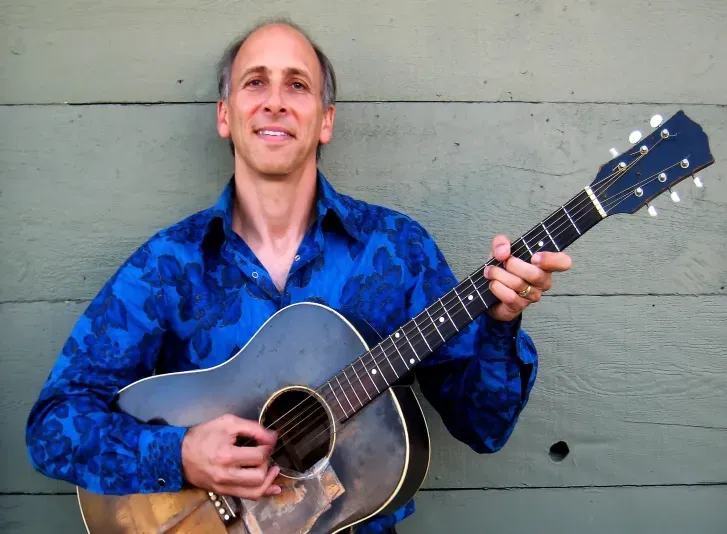Music historian Elijah Wald, a prominent presence at the Pop Conference at MoPOP, took a turn into old-time obscenity for his new book, Jelly Roll Blues: Censored Songs & Hidden Histories, about the life and times of New Orleans jazz musician Jelly Roll Morton (1890-1941).
Below are excerpts from a recent interview:
Andrew Hamlin: You write that "virtually no research on male sex workers or Gay life in New Orleans" at the turn of the 20th century exists. What did your own research uncover?
Elijah Wald: Frankly, very little. I'm completely baffled that there hasn't been more work done on that. New Orleans was a Gay mecca already, but the press did not tend to cover that.
There are lots of stories in interviews with people─ particularly in Jelly Roll Morton's world ─ talking about Tony Jackson, who was Gay, and saying he played at the Frenchman's [saloon], which was a Gay hangout. But nobody followed up. None of the interviewers ever say, "Could you say a little more about that?" I came up close to blank.
By the 1930s, there was a regular marching group at Mardi Gras called the Western Girls, Black men who dressed as women and had female names, and the suggestion is they'd been around for many years.
AH: What were the distinctive elements of the "pansy craze" from the late '20s to early '30s?
EW: That was about Gay male entertainers, specifically transvestite entertainers, for straight cabaret audiences. Largely I was finding [coverage] in the white press. It's a little messy, because there was a long, long history of Black male cross-dressing entertainers, who weren't necessarily performing as Gay. These guys were.
AH: What's the distinction between the two?
EW: Just that a lot of minstrel show performance was all male, and so if they were doing stories that had female characters, they'd be played by men. Like in Shakespeare. Whether these men were Gay, I don't know, but they were performing as women, not performing as ─ to use a term of the period ─ sissies.
Whereas [in] the "pansy craze," they were performing as sissies, and they were specifically doing off-color material, a lot of double entendre, a lot of single entendre. The act was their gayness.
For example, there was a man, Charles Anderson, who was the first person to perform "St. Louis Blues" in Black vaudeville, and his performance was simply as a woman. Whether he was Gay or not, I don't know, but that wasn't the act. Whereas Frankie "Half-Pint" Jaxon [from Chicago] was performing as a sissy. They all took female names: "The Bronze Mae West" or "The Ebony Eva Tanguay," those sorts of things.
The problem is, we don't have much of the material. Frankie "Half-Pint" Jaxon did do recordings, so we have a little. But not much.
AH: What were your impressions of those?
EW: They're funny. He's doing it in a high, feminine voice. He's being a female character. The classic (you can pull it up on YouTube) is his version of "How Long, How Long Blues," which was a very famous blues: "How long, how long, has that evening train been gone?" Except he does it (high voice) "How long, Daddy? How long? How long? How long?" and then does that over and over and ends up actually faking an orgasm on the record. This is from 1928. As far as I know, it's the first record of someone faking an orgasm. (laughs)
But again, how typical this was, I have no idea. Tony Jackson, his material was mostly not blues related; it was pop songs. His most famous song was "Pretty Baby," which apparently was written for his Gay male lover.
This is a world I would love for someone to do a proper exploration of. I have no idea what could be found, still. I know not a lot... in terms of documents. But I'd be interested in how much memory there is, in New Orleans.
AH: Morton's work sometimes seems like a ferocious onslaught of all possible obscenities, all possible orifices. Did you ever find yourself collapsing in exasperation, exhaustion, and/or uncontrollable laughter?
EW: I don't know about collapsing. A lot of it certainly amused me. There are points where it gets boring, the same thing over and over. But honestly, my main reaction was just being fascinated by the amount of this material, and how normal everyone seemed to think this material was, before commodification meant that it all had to get censored, so you could put it on records and put it in print.
Support the Seattle Gay News: Celebrate 50 Years with Us!
As the third-oldest LGBTQIA+ newspaper in the United States, the Seattle Gay News (SGN) has been a vital independent source of news and entertainment for Seattle and the Pacific Northwest since 1974.
As we celebrate our 50th anniversary, we need your support to continue our mission.
Your contribution will ensure that SGN remains a beacon of truth and a virtual gathering place for community dialogue.
Help us keep printing and providing a platform for LGBTQIA+ voices.
How you can donate!
Using this Link
Text "SGN" to 53-555
Or Scan the QR code below!


